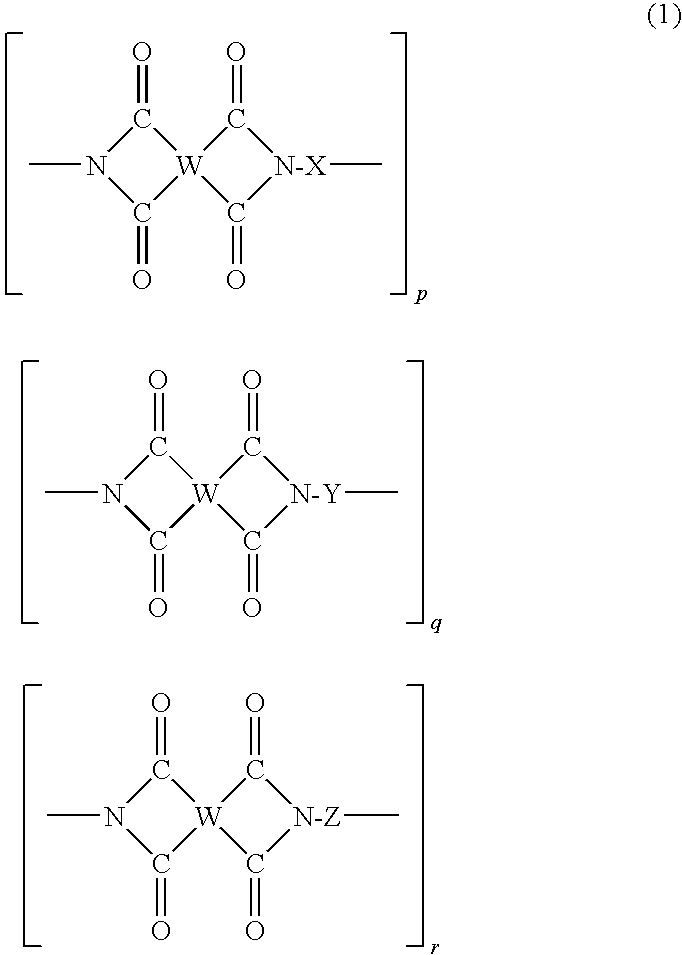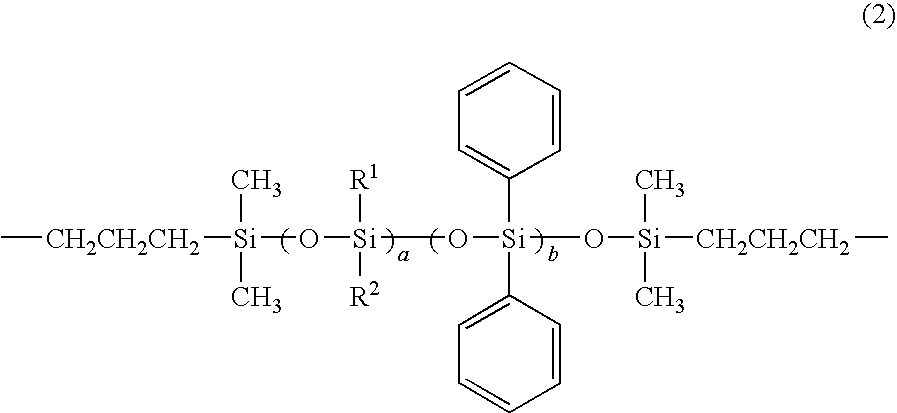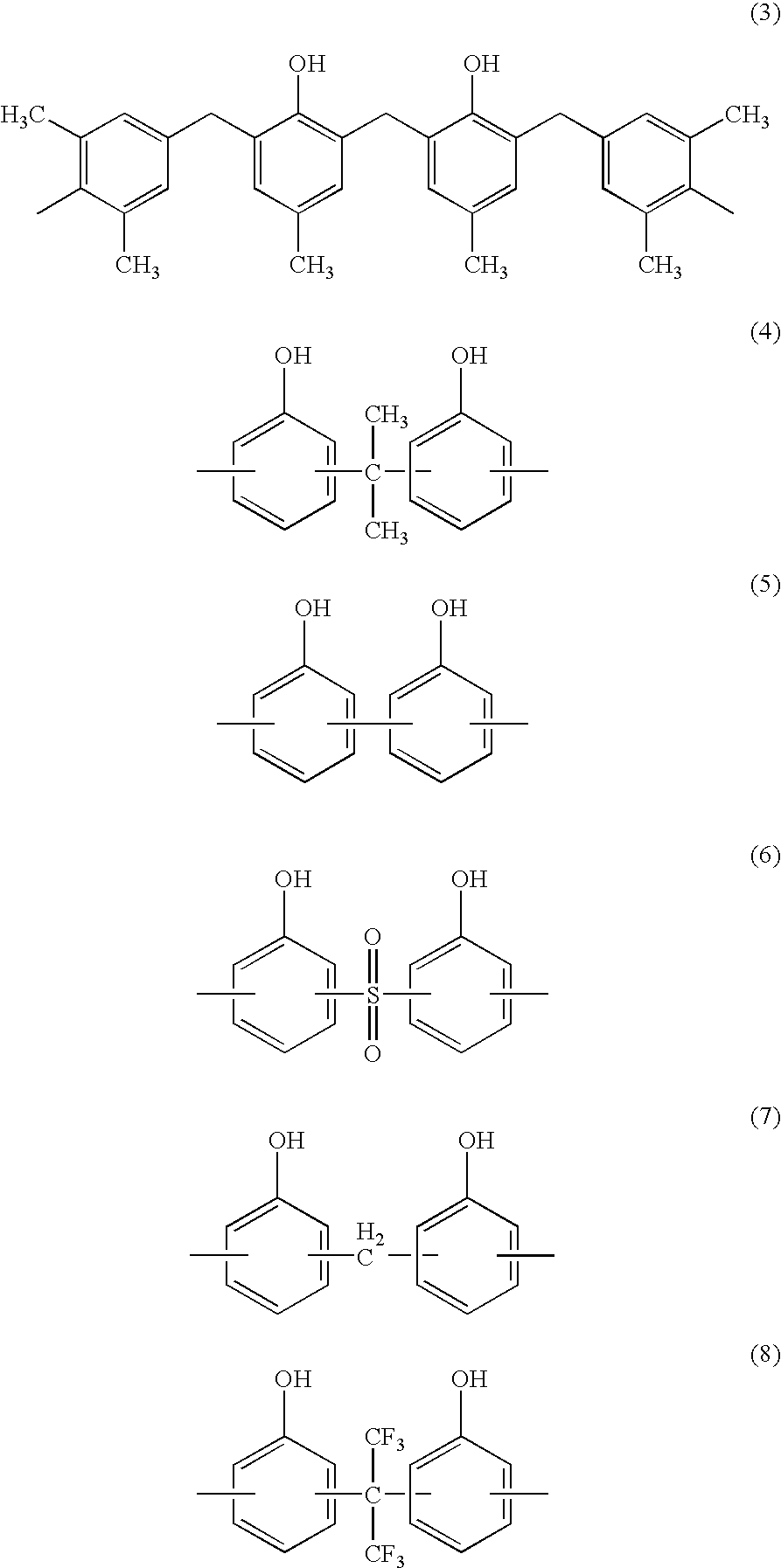Solvent-free polyimide silicone resin composition and cured product thereof
a technology of silicone resin and solvent-free polyimide, which is applied in the field of solvent-free or solvent-free polyimide silicone resin composition and the cure of its product, can solve the problems of no degree of freedom over thickness in use, unsuitable film for applications that require fluidity, and environmental burden, and achieve excellent adhesion reliability
- Summary
- Abstract
- Description
- Claims
- Application Information
AI Technical Summary
Benefits of technology
Problems solved by technology
Method used
Image
Examples
synthetic example 1
[0087]44.4 g (0.1 mol) of 6FDA and 400 g of NMP were charged into a flask equipped with an agitator, a thermometer and a nitrogen-purging device. Thereafter, a solution of 8.6 g (0.04 mols) of HAB and 65.3 g (0.06 mols) of PSI-A represented by the foregoing formula (18) dissolved in 100 g of NMP was dropped in the flask while controlling the temperature of the reaction system at a level not exceeding 50° C. After completion of the dropping, the reaction system was agitated at room temperature for 10 hours. Next, a reflux condenser equipped with a water acceptor was attached to the flask, to which 30 g of xylene was added, followed by raising the temperature to 150° C. and keeping at the temperature for 6 hours, thereby obtaining a yellowish brown solution. The thus obtained solution was cooled down to room temperature (25° C.) and charged into methanol, followed by drying the resulting precipitate to obtain polyimide silicone resin (a).
[0088]The resin was subjected to measurement of...
synthetic example 2
[0089]44.4 g (0.1 mol) of 6FDA and 400 g of NMP were charged into a flask equipped with an agitator, a thermometer and a nitrogen-purging device. Thereafter, a solution of 4.3 g (0.02 mols) of HAB, 98.0 g (0.06 mols) of PSI-A represented by the foregoing formula (18) and 8.2 g (0.02 mols) of BAPP dissolved in 100 g of NMP was dropped in the flask while controlling the temperature of the reaction system at a level not exceeding 50° C. After completion of the dropping, the reaction system was agitated at room temperature for 10 hours. Next, a reflux condenser equipped with a water acceptor was attached to the flask, to which 30 g of xylene was added, followed by raising the temperature to 150° C. and keeping at the temperature for 6 hours, thereby obtaining a yellowish brown solution. The thus obtained solution was cooled down to room temperature (25° C.) and charged into methanol, followed by drying the resulting precipitate to obtain polyimide silicone resin (b).
[0090]The resin was ...
synthetic example 3
[0091]44.4 g (0.1 mol) of 6FDA and 400 g of NMP were charged into a flask equipped with an agitator, a thermometer and a nitrogen-purging device. Thereafter, a solution of 8.6 g (0.04 mols) of HAB and 98.0 g (0.06 mols) of PSI-B represented by the foregoing formula (19) dissolved in 100 g of NMP was dropped in the flask while controlling the temperature of the reaction system at a level not exceeding 50° C. After completion of the dropping, the reaction system was agitated at room temperature for 10 hours. Next, a reflux condenser equipped with a water acceptor was attached to the flask, to which 30 g of xylene was added, followed by raising the temperature to 150° C. and keeping at the temperature for 6 hours, thereby obtaining a yellowish brown solution. The thus obtained solution was cooled down to room temperature (25° C.) and charged into methanol, followed by drying the resulting precipitate to obtain polyimide silicone resin (c).
[0092]The resin was subjected to measurement of...
PUM
| Property | Measurement | Unit |
|---|---|---|
| temperature | aaaaa | aaaaa |
| temperature | aaaaa | aaaaa |
| molar ratio | aaaaa | aaaaa |
Abstract
Description
Claims
Application Information
 Login to View More
Login to View More - R&D
- Intellectual Property
- Life Sciences
- Materials
- Tech Scout
- Unparalleled Data Quality
- Higher Quality Content
- 60% Fewer Hallucinations
Browse by: Latest US Patents, China's latest patents, Technical Efficacy Thesaurus, Application Domain, Technology Topic, Popular Technical Reports.
© 2025 PatSnap. All rights reserved.Legal|Privacy policy|Modern Slavery Act Transparency Statement|Sitemap|About US| Contact US: help@patsnap.com



